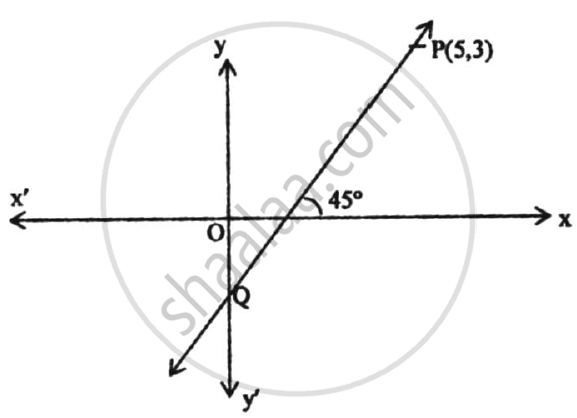Advertisements
Advertisements
प्रश्न
The line passing through (−4, −2) and (2, −3) is perpendicular to the line passing through (a, 5) and (2, −1). Find a.
उत्तर
Slope of the line passing through (−4, −2) and (2, −3) is m1
`m_1 = (-3 + 2)/(2 + 4) = (-1)/6`
Slope of the line passing through (a, 5) and (2, −1) is m2
`m_2 = (-1 - 5)/(2 - a) = (-6)/(2 - a)`
Since, the lines are perpendicular
`m_1 = (-1)/m_2`
∴ `(-1)/6 = (-1)/((-6)/(2 - a))`
∴ `(-1)/6 = (2 - a)/6`
∴ (2 – a) = –1
∴ a = 3
APPEARS IN
संबंधित प्रश्न
The line through P(5, 3) intersects y-axis at Q.
(1) Write the slope of the line.
(2) Write the equation of the line.
(3) Find the coordinates of Q.

The line passing through (0, 2) and (−3, −1) is parallel to the line passing through (−1, 5) and (4, a). Find a.
(−2, 4), (4, 8), (10, 7) and (11, –5) are the vertices of a quadrilateral. Show that the quadrilateral, obtained on joining the mid-points of its sides, is a parallelogram.
The slope of the side BC of a rectangle ABCD is `2/3`. Find:
- the slope of the side AB.
- the slope of the side AD.
The points (−3, 2), (2, −1) and (a, 4) are collinear. Find a.
Angles made by the line with the positive direction of X–axis is given. Find the slope of these line.
60°
Determine whether the following point is collinear.
R(1, –4), S(–2, 2), T(–3, 4)
Find the slope of a line, correct of two decimals, whose inclination is 60°
Find the slope of a line passing through the points (x, 9) and (12, 6) is `(-1)/3 = ("y"_2 - "y"_1)/("x"_2 - "x"_1)`
With out Pythagoras theorem, show that A(4, 4), B(3, 5) and C(-1, -1) are the vertices of a right angled.
